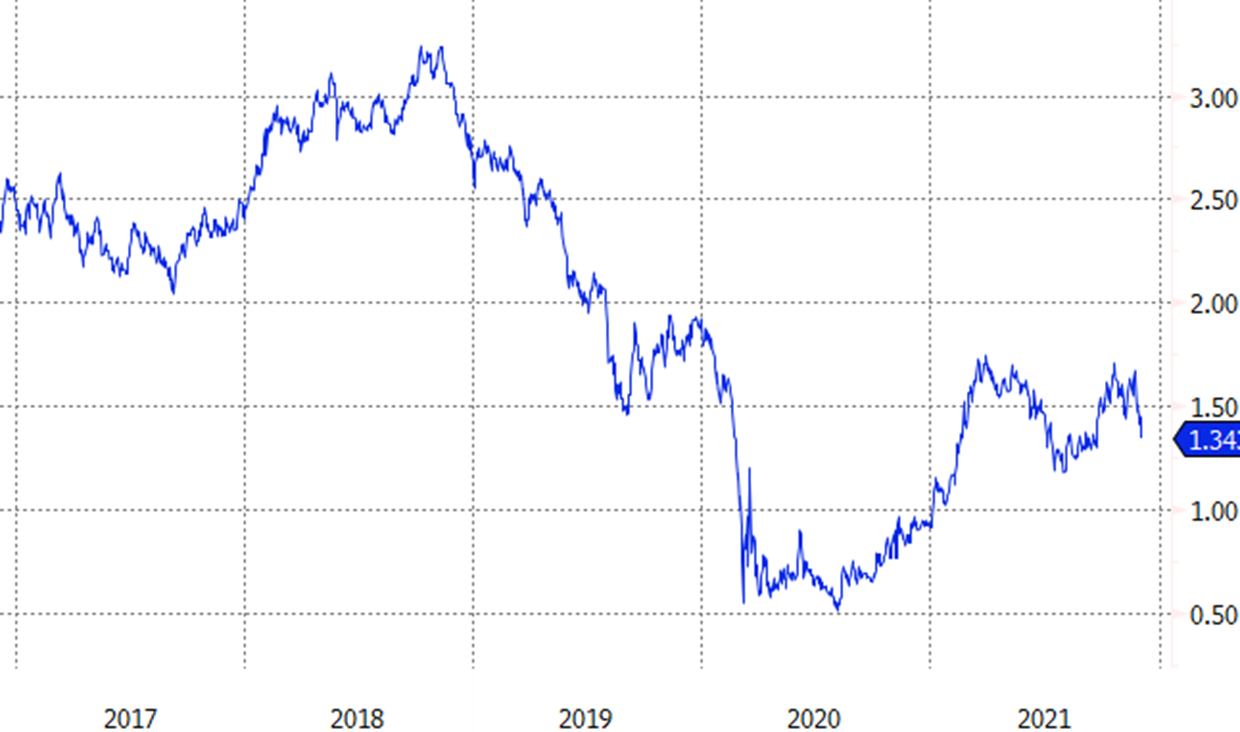Most investors expected interest rates would rise heading into 2021 – and they were right.
But if you told someone at the start of the year that inflation would accelerate to a three-decade high, they would probably be surprised to hear how little interest rates have gone up.
So, while rates have risen as expected, they are not up nearly as much as many would have imagined given the circumstances.
The 10-year Treasury bond yield started the year at 0.91%, and today it sits at 1.38%. Outside of the rock-bottom levels reached during the height of the coronavirus pandemic in 2020, these are among the lowest rates for the 10-year in modern history.
Chart 1: 10-year Treasury bond yield

It is a confusing situation for investors. Inflation is surging and the Fed is giving all indications that it is ready to tighten monetary policy faster than many had anticipated, and yet the most important interest rate in the US is going nowhere fast.
There are myriad theories explaining what is going on but the simplest is that bond traders do not believe inflation will stay high for long, and therefore they do not think the Fed will have to hike its benchmark federal funds rate very much when it begins raising rates sometime in the not-too-distant future.
This theory explains why the five, 10 and 30-year Treasuries are yielding only 1.17%, 1.38% and 1.7%, respectively. If traders thought the Fed would hike the fed funds rate to 2%, 3% or even more, those Treasury bonds would not be yielding so little.
Bond losses modest
Still, expectations do not always line up with reality. Inflation could stay stubbornly elevated, forcing the Fed and bond traders to react. If rates rose significantly, that could potentially lead to steep losses for fixed income ETFs.
Those steep losses have not materialised so far since rates are not up all that much this year. The iShares $ Treasury Bond 7-10yr UCITS ETF (IBTM) is only down 2.3% year-to-date; the iShares $ 20+ Year Treasury Bond UCITS ETF (IDTL) is lower by 0.7%; the iShares $ Corp Bond UCITS ETF (LQDE) has lost 0.7%; and the iShares $ High Yield Corp Bond UCITS ETF (SHYU) is up 2.2% this year, as credit spreads have narrowed.
And let us not forget about the iShares US Aggregate Bond UCITS ETF (SUAG) which has only lost 1% this year. That is not bad in light of the macroenvironment.
Hedging the risk
That does raise the question, are bond traders being too complacent? Should they be demanding higher interest rates as compensation for the risk of persistent, elevated inflation?
The answer to that depends on your personal views about inflation and rates. The market view is clear (though it can change). If you believe inflation will be higher and more persistent than the market does, perhaps it makes sense to underweight bonds in your portfolio.
If that is too drastic a step, something like the iShares $ TIPS Bond UCITS ETF (ITPS) might make sense. Treasury inflation-protected securities (TIPS) can be used to hedge against higher inflation while maintaining your exposure to the Treasury bond market.
If inflation runs hotter than what is currently embedded in markets, the government will compensate TIPS holders. Essentially, with TIPS, you are locking in a particular “real” (inflation-adjusted) interest rate. With conventional bonds, you are locking in a nominal rate.
When inflation runs hotter than expected, TIPS outperform. And when inflation is less than expected, regular bonds outperform.
This year, with inflation running far higher than anyone expected, TIP is up 5.4%, sharply outperforming other Treasury bond ETFs.
Investors have taken notice. The US-listed iShares TIPS Bond ETF (TIP) has pulled in nearly $11bn inflows this year, bringing its total AUM to $37.7bn. That makes it the seventh-largest fixed income ETF on the US market.
If inflation stays high, you can bet TIP will only get bigger from here.
This story was originally published onETF.com
Further reading


